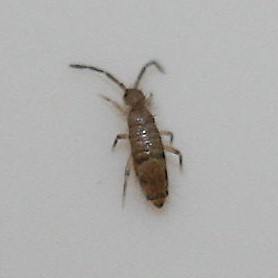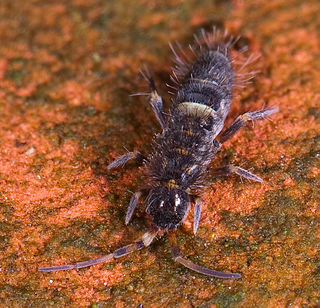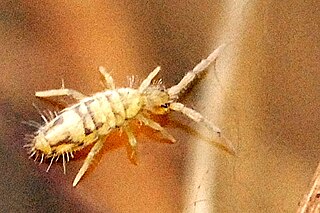
Entomobryidae, sometimes called "slender springtails", is a family of springtails characterised by having an enlarged fourth abdominal segment and a well-developed furcula. Species in this family may be heavily scaled and can be very colourful. The scale-less Entomobryidae are commonly caught in pitfall traps around the planet, and also occur in canopy faunas high up in trees. There are more than 1700 described species in Entomobryidae.

Springtails form the largest of the three lineages of modern hexapods that are no longer considered insects. Although the three orders are sometimes grouped together in a class called Entognatha because they have internal mouthparts, they do not appear to be any more closely related to one another than they are to all insects, which have external mouthparts.

Entomobrya is a genus of slender springtails in the family Entomobryidae. There are at least 270 described species in Entomobrya.
Entomobrya clitellaria is a species in the family Entomobryidae, in the order Entomobryomorpha.
Pseudosinella spinosa is a species of slender springtails in the family Entomobryidae.

Entomobrya lanuginosa is a species of springtail in the genus Entomobrya.

Entomobrya unostrigata, the cotton springtail, is a species of slender springtails in the family Entomobryidae.
Entomobrya ligata is a species of slender springtails in the family Entomobryidae.
Entomobrya comparata is a species of slender springtails in the family Entomobryidae.
Entomobrya sinelloides is a species of slender springtails in the family Entomobryidae.

Entomobrya nivalis, the cosmopolitan springtail, is a species of slender springtails in the family Entomobryidae.
Entomobrya washingtonia is a species of slender springtails in the family Entomobryidae.
Entomobrya suzannae is a species of slender springtails in the family Entomobryidae.
Entomobrya assuta is a species of slender springtails in the family Entomobryidae.
Entomobrya griseoolivata is a species of slender springtails in the family Entomobryidae.

Entomobrya intermedia is a species of slender springtails in the family Entomobryidae.
Entomobrya bicolor is a species of slender springtails in the family Entomobryidae.
Entomobrya triangularis is a species of slender springtails in the family Entomobryidae.
Entomobrya confusa is a species of slender springtails in the family Entomobryidae.
Entomobrya decemfasciata is a species of slender springtails in the family Entomobryidae.






